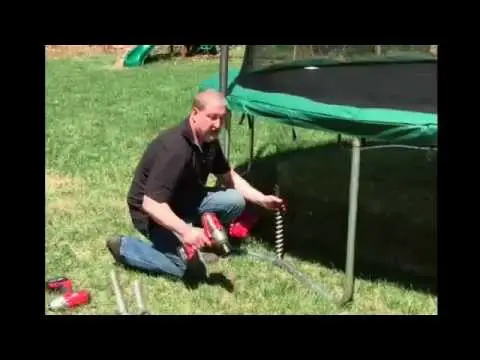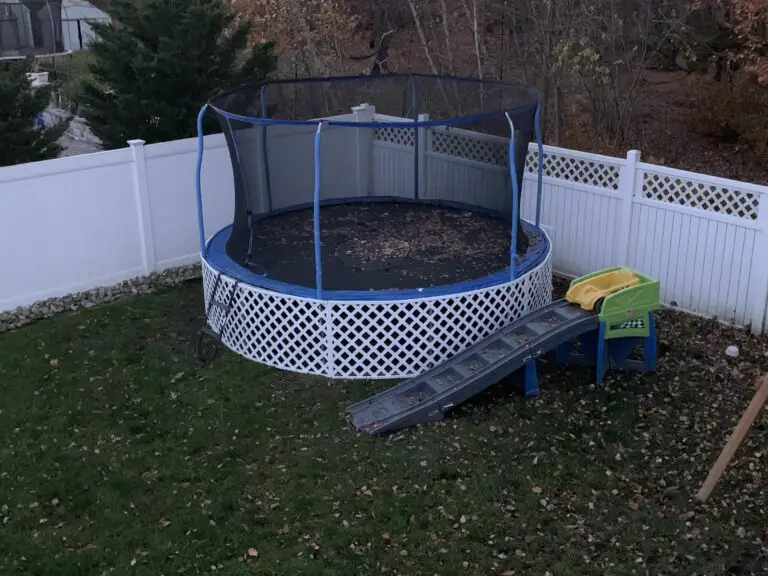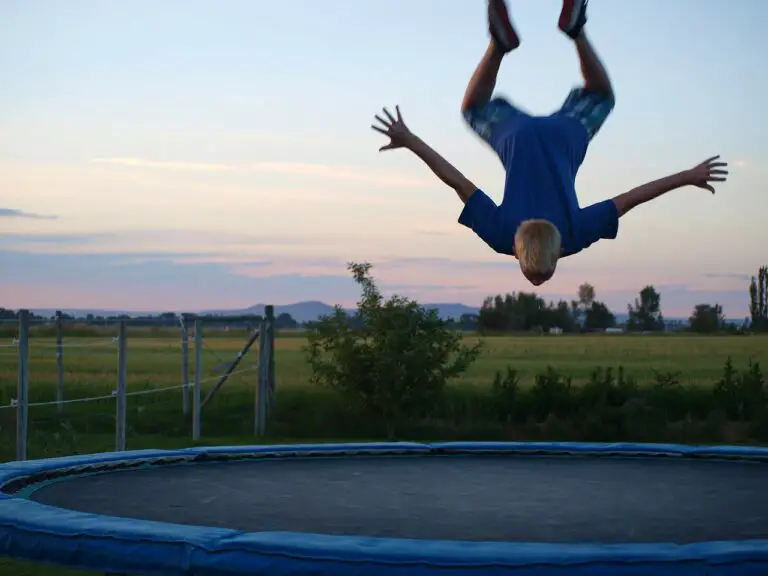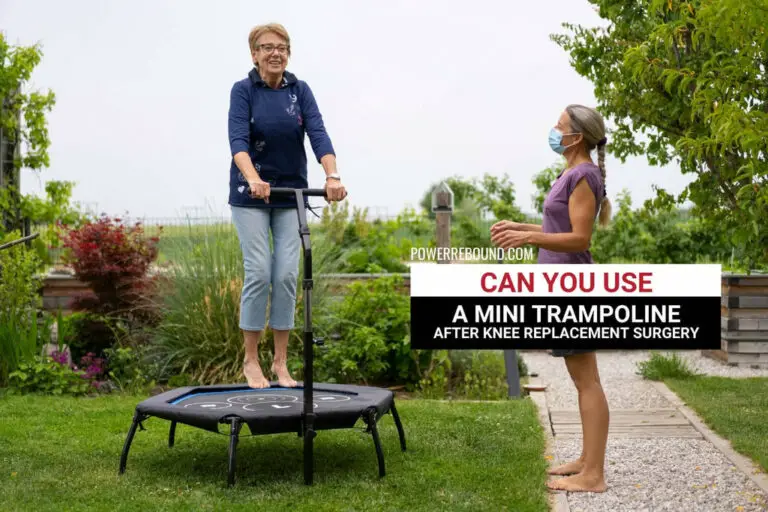Do you have a trampoline in your backyard, but live in an area which is prone to storms or hurricanes? If so, it is important to properly anchor the trampoline to the ground. Without the right anchoring system, strong winds can cause your trampoline to become airborne and cause damage to property and even harm people. In this blog post, we will discuss how to properly anchor a trampoline in order to keep it safe during strong storms and hurricanes. We’ll also provide tips on which type of anchoring system might be best suited for your needs. By following these guidelines, you can ensure that your trampoline remains secure in heavy wind conditions. Read on for more information!
The Best Way To Anchor A Trampoline
Importance of Anchor for Trampolines
Trampolines can pose significant safety risks if not properly secured to the ground. The importance of anchoring trampolines lies in their ability to prevent accidents and injuries. Anchors offer stability and firmness, which enhances the performance and longevity of the trampoline. It keeps the trampoline from tipping over or getting displaced during use, especially when subjected to strong winds and other environmental factors. In summary, proper anchoring is imperative to ensure safe and enjoyable trampoline experiences for everyone.
Trampoline anchors are available in different types and sizes, and their suitability depends on factors such as the trampoline’s size and shape, the type of surface it’s placed on, and the prevailing weather conditions. Concrete screws, Augers, and U-shaped stakes are commonly used to anchor trampolines to the ground securely. Regardless of the anchor type, it’s essential to install them correctly and regularly check for any loose or damaged anchors.
Furthermore, when anchoring the trampoline, it’s essential to leave sufficient clearance of at least six feet around the edges to prevent collisions with nearby objects or the ground. Another important aspect to consider is the location of the anchor points, which should align with the trampoline’s frame’s legs.
Pro Tip: To ensure maximum security, it’s best to install as many anchor points as possible and at regular intervals around the trampoline. This greatly reduces the risk of accidents and improves the overall performance and longevity of the trampoline.
Types of Trampoline Anchors
When it comes to anchoring a trampoline, there are a variety of options available. In fact, there are so many choices, it can be hard to know where to start! Personally, I’ve found it helpful to break it down by the type of anchor.
First, let’s take a look at trampoline anchors. They come in a few different styles and materials, each with its own unique benefits.
Next up, we’ll dive into wind stakes, which are a popular choice for those who live in areas with high winds. I’ll explain how they work and what sets them apart from other types of trampoline anchors.
Trampoline Anchors
Trampoline anchors play a significant role in securing the trampoline to prevent it from moving or flipping due to wind or weight. These anchors come in various types and sizes, each with a unique purpose.
A 5-step guide to effectively anchor trampolines involves:
- Measuring and marking the location
- Installing pickets
- Securing with hook and loop straps
- Using ratchets to tighten the anchor
- Repeating the process on all sides of the trampoline.
To ensure maximum safety, it is important to use durable materials such as steel stakes or augers with straps positioned at an angle for improved stability. Further adjusting the tension on the straps according to weather conditions can also be beneficial.
In one instance, a family failed to properly anchor their trampoline which led to it being blown away by strong winds causing damage to nearby property. Thus indicating the importance of proper anchoring procedures.
Because gravity won’t let go, U-shaped trampoline anchors will keep your bounce in check.
U-shaped Trampoline Anchors
U-shaped trampoline anchors are a type of anchoring system that securely stabilizes the trampoline to the ground. They are designed in a U-shape for easy installation and removal, making them highly popular among trampoline owners.
A table can be created to compare the different types of trampoline anchors, including U-shaped anchors, wind stakes and auger anchors with straps respectively. The table can include columns such as anchor type, material used, ease of installation, durability and cost.
In addition to their ease of use, U-shaped trampoline anchors are made of high-quality steel and have a durable powder-coated finish that resists rust and corrosion. These features ensure that they last for many years without any degradation or weakness.
For optimal safety measures, it’s advisable to use at least four U-shaped trampoline anchors on each corner; this provides better stability and holds down the structure in high-wind conditions.
To maintain efficient U-shaped trampoline anchor installation:
- Properly measure the distance from each corner of the trampoline.
- Select an appropriate length picket for your site grass length requirements.
- Insert your picket into the ground using a claw hammer or rubber mallets.
- Hook up your strap ratchet to your chosen anchor point on your picket stake.
- Keep pulling until all slack is out of your strap before tightening it around picket stake surface area tightly.
- Repeat these steps four times for optimal results.
Overall U-shaped trampoline anchors with their sturdy construction provide complete security against movement and keep people safe while rebounding on their trampolines with peace of mind. Secure your trampoline with the power of augers and straps, because bouncing to infinity and beyond isn’t always a good thing.
Auger Trampoline Anchors with Straps
Auger Trampoline Anchors with Straps are designed to be screwed into the ground and attached to the trampoline frame using straps.
The augers provide stability by creating a firm hold in the ground, while the straps help to keep the trampoline securely attached to the anchor. This type of anchor is suitable for use on grassy or soft ground, where traditional U-shaped anchors may not be able to provide a strong enough hold against wind and pressure.
It is important to note that Auger Trampoline Anchors with Straps may require more effort and time to install than other types of anchors, as you will need to screw them into the ground. However, they offer superior stability and protection for your trampoline.
According to the article, Trampolines should always be anchored for maximum safety. Put your trust in wind stakes because you never know when Mother Nature wants to join your trampoline party.
Wind Stakes
When it comes to anchoring trampolines, wind stakes are an essential component for stability in areas prone to strong gusts of wind.
- Wind Stake Material and Positioning: Wind stakes are typically made from sturdy materials like steel or aluminum. They come in different lengths, but generally need to be at least 12-16 inches long to provide adequate support.
- Tapping into the Ground: To install wind stakes, use a mallet or hammer to tap them firmly into the ground at a 45-degree angle. It’s best to place them near each leg of the trampoline for maximum support.
- Add extra Wind Stakes based on the severity of the weather conditions. The more severe the conditions, the more stakes you’ll want. Generally speaking, six wind stakes per trampoline is a good rule of thumb.
For areas that experience consistently high winds, it’s recommended to purchase heavy-duty wind stakes or additional types of anchoring systems.
To keep your trampoline secure and prevent accidents caused by an unstable structure, don’t skimp on anchoring mechanisms like wind stakes. Don’t risk damaging your trampoline or putting someone in danger by overlooking this critical component of setup and maintenance.
Anchoring your trampoline is like securing your seatbelt, just with a lot more jumping.
How Trampoline Anchors Work
I’m sure you’ve heard of the dangers of having an unsecured trampoline in your backyard. A sudden gust of wind can lift it off the ground and cause serious damage or even injury. That’s why I decided to look into trampoline anchors and how they work.
Through my research, I discovered that trampoline anchors come in various forms and can be used on both soft and hard surfaces. In this section, we’ll delve into the different types of trampoline anchors available, the materials required for each type, and the process for anchoring a trampoline.
Anchoring Process on Soft Ground
Anchoring Trampolines on Soft Ground requires specific materials and processes that ensure safety and stability. The anchoring process on soft ground involves measuring, marking, picking installation, hooking and looping, ratchet installation, tightening, and repetition until all anchors are tightly secured into the soil.
For a better understanding of the Anchoring Process on Soft Ground for trampolines, the following table outlines the necessary materials required for the process:
| Material Required | Quantity |
|---|---|
| Pickets | 4-6 |
| Ratchet Straps | 2-3 |
| Hooks & Loops | 2-3 Sets |
It is vital to use appropriate materials such as Y-shaped PVC-coated steel stakes or auger-shaped stakes with straps for efficient anchorage. Always place the trampoline over well-drained soil where waterlogging is minimal to avoid erosion around the stakes.
Unique details to consider when Anchoring Trampolines on Soft Ground include examining the soil type and depth, ensuring careful stake placement within recommended distances from each corner of the trampoline frame. For example, Pick every opposite corner starting from one end of your trampoline by marking with some wooden dowl.
To improve efficiency in binding pickets into soft soils such as sand or loam – use a prolonged bar or a bailer screwdriver-shaped stake to dig through coupled rocks underground first before applying force so that it may skip smaller rocks.
For best results in Anchoring Trampolines on Soft Ground consider spreading grass seed over bare spots alongside other protective measures to prevent excess soil erosion. Additionally, thoughtful consideration when selecting stake placements ensures stable anchors that keep your loved ones safe during hours of fun-jumping! Better stock up on these materials or risk sending your trampoline and kids flying.
Materials Required
To ensure a secure trampoline set up, certain items are needed beyond the trampoline itself. The Materials Required for anchoring include:
- U-shaped Trampoline Anchors
- Auger Trampoline Anchors with Straps
- Wind Stakes
U-shaped and Auger anchors are designed to provide maximum stability when installed correctly while wind stakes are more suited for lightweight or smaller trampolines.
It is essential to consider ground quality when selecting an anchor; deeper or sturdier options may be necessary for soft ground. Ultimately, the material used should be durable enough to withstand weather conditions.
Proper installation of materials required means using a measuring tape, chalk line, as well as a picket hammer/drill and ratchet tool.
Pro Tip: As an added layer of safety, it is best to install more anchor points than less when setting up your trampoline.
Securing a trampoline is like securing your heart – both need a picket, a ratchet, and a lot of love.
Anchoring Process
The process of anchoring a trampoline helps to keep it in place and prevent it from tipping over in windy conditions. Here is a brief guide on how to complete the ‘Anchoring Process’ for a trampoline:
- Measure and mark the location where you want to place your anchors.
- Install the picket by driving it into the ground at an angle towards the trampoline frame.
- Secure the hook and loop strap around the picket’s head and attach it to one of the trampoline’s legs.
- Thread the ratchet strap through the U-shaped anchor, attach it to another leg on the opposite side of the trampoline, and tighten until secure.
- Repeat this process for all other anchor points needed.
It is essential to use appropriate materials during this anchoring process, including U-shaped anchors, auger-style stakes with straps, or wind stakes. These materials can be made of heavy-duty steel or other suitable materials.
When planning to anchor a trampoline on soft ground surfaces such as grass or soil, ensure that you check out for buried pipes or cables or other potential hidden hazards before anchoring.
It is vital also to position wind stakes at least 2 feet away from each leg of your anchored trampoline. This proper positioning ensures maximum resistance against wind-related issues like tip-overs.
There have been cases recorded about trampolines causing accidents due to improper anchoring processes or lack thereof. Therefore, such accidents can be avoided by properly following manufacturer guidelines when installing your new backyard equipment.
Get your measuring tape ready and let’s make sure your trampoline doesn’t take flight like Mary Poppins.
Measure and Mark
The process of measuring and marking is essential when anchoring a trampoline. This helps in ensuring that the trampoline is fixed in a stable position.
A 5-step guide to measure and mark:
- Determine the suitable location for anchoring by assessing the type of ground surface.
- Measure and mark four points on the ground surface that align with each leg of the trampoline frame.
- Use a measuring tape to ensure the distance between each mark and its corresponding leg is equal.
- Double-check your measurements before proceeding to install pickets.
- Adjust your markers accordingly if necessary, ensuring they are properly aligned before continuing.
It is crucial to ensure correct measurement and marking before proceeding with the anchoring process, as this determines how stable the trampoline will be in use.
Pro Tip: Make sure you take into account any manufacturer recommendations or local regulations for trampolines in your area before beginning the anchoring process.
Installing a picket for a trampoline is like playing a giant game of Jenga – one wrong move and the whole thing could come crashing down.
Install the Picket
To properly secure a trampoline, it is essential to install the picket. This step involves inserting a metal stake into the ground and attaching it to the trampoline frame using straps or hooks.
To install the picket:
- Find a suitable location for anchoring.
- Use a measuring tape to determine the proper distance from each leg of the trampoline to where you will insert the stake.
- Insert the metal stake vertically into the ground at an angle towards the trampoline.
- Loop straps or hooks around the base of each leg and attach them to the eyelets on the stakes.
- Ratchet down each strap or hook tightly securing it in place.
- Repeat this process for each leg until all stakes are secured.
It’s important to note that different types of soil require different types of pickets and materials for anchoring purposes.
Interestingly, according to a study by Consumer Product Safety Commission (CPSC), between 2000 and 2009, more than 64,000 emergency room visits were related to trampolines, with most injuries associated with falls off of a trampoline or attempting stunts. Hook and loop, the trampoline stays put – just like my ex after I anchor them down with my charm.
Hook and Loop
The Fastening Process:
- Use a series of steps that connect one item to another.
- The process involves the use of two components, namely the hook and the loop.
- Once the hooks are firmly embedded in one item, they can cling onto the loops on another item.
- Hook and Loop fastening is essential when installing trampoline anchors.
Unique Detail:
Trampoline anchoring requires precision to secure it firmly. The hook and loop fastening should be tight to prevent the trampoline from moving away during jumping sessions.
Fun Fact:
According to a study conducted by American Academy of Pediatrics, over 90 thousand cases related to trampoline injuries are recorded every year.
Get ready to ratchet up the safety of your trampoline with these installation tips.
Install the Ratchet
To secure the trampoline, the ratchet needs to be installed properly. The ratchet is a critical component in the anchoring process for trampolines. Here is a step-by-step guide to installing the ratchet:
- Loop one end of the strap through the bracket and back up to create a half hitch.
- Use a pair of pliers to tighten this down as much as possible.
- Tighten evenly on both sides of the bracket so that there isn’t any slack in either side of the strap.
- Once this is done, install a second half-hitch with the strap looping through the buckle this time.
- Pull tightly on this until it feels like there isn’t any give left in the system.
- Test your work by trying to lift one side of your trampoline off its supports. If everything holds firm, you can repeat these steps on each corner until all four are finished.
A unique detail to keep in mind while installing a ratchet is that if your straps are not tightened down enough, then they may still be able to shift around under different types of load. This could cause them to slip out of place or create other potentially hazardous situations. According to National Trampoline Safety Board research, improper anchoring was found to contribute significantly towards accidents and injuries related with trampolines. Remember, tight and secure trampoline anchors mean happy and safe jumpers.
Tighten and Repeat
To secure the trampoline firmly, it is essential to follow the anchoring process correctly. Tighten and repeat is a crucial step in this process of trampoline anchoring. It involves ensuring that all bolts, ratchets, and straps are tightened multiple times to attain maximum stability.
Here is a 6-step guide on how to tighten and repeat during trampoline anchoring:
- Double-check the placement of every anchor point before you start tightening.
- Tighten each strap on both sides of the U-shaped anchor using a 1/2 inch socket wrench
- Do not fully tighten each strap in one go instead tighten them round-robin style.
- During this stage, ensure that the strap loops around the legs and slides down by pushing it with your foot or hand
- You can use a rubber mallet or hammer to tap down any offset spikes after stapling them in place
- If you feel any looseness when stepping back on the mat, then repeat steps 2-5 until everything feels tight.
It is advisable to check for firmness and stability continuously, as even small lapses can cause injury. Moreover, aligning all anchors at once helps eliminate time wastage which could happen if done separately.
One real-life story narrated by an experienced trampoline user emphasized the importance of tightening every bolt accurately without leaving out any step in order to heal while avoiding injuries. When his child went soaring through the air due to loose bolts when jumping onto their trampoline, he understood thoroughly that avoidable errors can have life-changing consequences.
If your trampoline takes flight, it’s not impressive, it’s dangerous – use wind stakes to keep it grounded.
Using Wind Stakes to Anchor Trampoline
As a trampoline owner, I know how important it is to keep my trampoline stable and secure, especially in areas that experience high winds. One effective method for anchoring a trampoline is by using wind stakes. In this part of the article, I’ll dive into the specifics of using wind stakes to anchor a trampoline. We’ll cover two key aspects: wind stake material and positioning, and tapping into the ground. With these tips and tricks, you can be confident that your trampoline will stay safely in place during windy weather.

Credit: www.zupapa.us
Wind Stake Material and Positioning
For Wind Stake Material and Positioning, choosing the appropriate material and installing it correctly is crucial for securing your trampoline. Here’s a table that lists popular wind stake materials and provides information on their features and benefits:
| Material | Features/Benefits |
|---|---|
| Steel | Durable, long-lasting, can withstand high winds |
| Aluminum | Lightweight, rust-resistant, easy to install |
| Galvanized steel | Resistant to corrosion, suitable for wet climates |
When positioning your wind stakes, consider the direction of prevailing winds in your area. Install the stakes at a 45-degree angle away from the trampoline to provide maximum stability. Also, ensure that the stakes are driven far enough into the ground to prevent loosening or pulling out during high winds.
To prevent damage or instability caused by heavy gusts or storms, regularly check your wind stakes for signs of wear or looseness. If necessary, replace broken or damaged stakes promptly.
By selecting an appropriate wind stake material and properly positioning them, you can have peace of mind knowing that your trampoline is secure against strong winds.
Tapping into the ground: not just for vampires anymore.
Tapping into the Ground
To stabilize the trampoline, tapping into the ground is a crucial process. It involves installing a stake securely in the ground to reduce any movement caused by strong winds or jumping.
| Step | Description |
| 1 | Choose a spot around the base of the trampoline where you want to install your anchoring. |
| 2 | Use a hammer or mallet to tap the stake into the ground at an angle of around 45 degrees towards the trampoline feet. |
| 3 | Ensure that the stake is deep enough – roughly equal to its length – to ensure it provides enough support. |
It is essential to ensure that the stake is positioned at an appropriate location close enough to work correctly, without affecting wire or drainage systems.
Pro Tip: Always use thick and robust stakes hammered deeply into hard-packed soil for better stability.
FAQs about How To Anchor A Trampoline
1. Why do I need to anchor my trampoline?
It is essential to anchor your trampoline to prevent it from being blown away in high winds. A flying trampoline can cause severe damage to other structures or objects and ruin your investment.
2. What are the best ways to anchor a trampoline?
There are two primary ways to anchor a trampoline, including trampoline anchors and wind stakes. Trampoline anchors come in long, twisting rods, while Wind stakes are buried into the ground with cement binding before placing the trampoline over them. Both methods offer effective ways to hold the trampoline in place.
3. How do trampoline anchors work?
Trampoline anchors hold the trampoline firmly in one place and prevent it from being lifted away by wind. The most common anchors come in U-shaped or auger shape, made of steel, and fit around the base poles of your trampoline. The auger-shaped anchors come with straps that attach from the auger to the trampoline frame to secure it.
4. How to secure your trampoline with wind stakes?
Wind stakes are easy to install as they only require a corkscrew shape steel stake drilled into the ground. You can center the wind stakes on the trampoline leg, spacing them two inches apart, to provide the best stability. Tap the stakes into the ground with a hammer until they are firmly in place.
5. What materials do I need to anchor down my trampoline?
To secure your trampoline using a simple trampoline wind anchor kit, you will need an anchor kit, four ratchet straps, a carpenter hammer or metal sledgehammer, and a tape measure (recommended but not necessary).
6. What is the best trampoline anchor kit to buy?
There are many anchor kits available in the market. Some recommended products include Eurmax USA Trampoline Anchor Kit, Heavy Duty Trampoline Anchor Tie Down Kit, and Anchor Tie Downs for Trampoline and Swing Sets. It ultimately depends on personal preference and the size and shape of your trampoline.
Conclusion
The process of anchoring a trampoline is a crucial step that needs to be executed with care. It ensures safety and minimizes the risk of accidents. Proper anchoring of trampoline is necessary to provide stability and increase durability. Understanding the significance of anchoring a trampoline is vital for every trampoline owner.
Executing the steps mentioned in the reference data will guarantee a stable trampoline that is safe to use. However, before starting, it is essential to gather all the necessary tools and check the condition of the trampoline. In addition, anchoring must be done on a flat surface to maintain the stability of the trampoline.
It is worth noting that the level of soil moisture and wind speed can also affect the anchoring process. Therefore, carefully selecting the location and anchoring material is vital. Understanding the environmental factors is crucial before deciding on the anchoring method.
Traditionally, trampolines were only anchored with stakes or ropes. However, with evolving technology, there are now several anchoring methods available that are more durable and reliable. It is crucial to choose the best-suited method for the trampoline as per the recommended guidelines.






